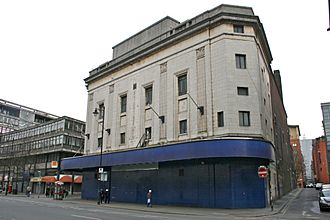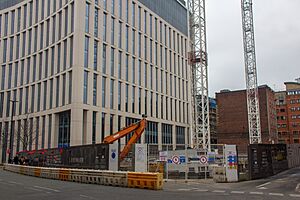Odeon Cinema, Manchester facts for kids
Quick facts for kids Odeon Cinema, Manchester |
|
|---|---|

Odeon Cinema in 2009
|
|
| General information | |
| Type | Cinema |
| Location | Manchester, England |
| Coordinates | 53°28′37.34″N 2°14′33.72″W / 53.4770389°N 2.2427000°W |
| Opening | October 1930 |
| Closed | September 2004 |
| Demolished | April 2017 |
| Design and construction | |
| Developer | F. Verity and S. Beverley |
The Odeon Cinema, Manchester was once a famous movie theater in Manchester, England. It was located on Oxford Street, near St. Peter's Square. This area is part of Manchester city center.
The cinema was originally called the Paramount Theatre. It was torn down in April 2017. A new 14-story office building, called Landmark, now stands in its place. This change was part of a big project to update the area.
Contents
History of the Site
The land where the cinema stood was first developed around the late 1700s. By the 1830s, it had many different buildings, including homes and businesses. By the early 1900s, it was all business properties, even two pubs. All these buildings were cleared away by 1930 to make room for the new Paramount Theatre.
The Paramount Theatre Opens
The Paramount Theatre opened its doors on October 6, 1930. The first movie shown was The Love Parade. There was also a live variety show on stage.
The Paramount Film Company of America built this theater. It was designed by architects Frank Verity and S. Beverley. They also designed the Plaza Theatre in London. The Manchester Paramount was one of the first of 50 planned Paramount Theatres. It was the very first in the UK to use the company's name. Other Paramount cinemas opened in cities like Leeds, Newcastle upon Tyne, and Glasgow.
Inside the Cinema
This cinema had one large screen. It could seat 2,920 people on two levels: the Stalls (ground floor) and the Balcony (upper level). The building also had a full stage, dressing rooms, and an orchestra pit. There was even an organ and a cafe.
The cinema was built for both movies and live shows. It mostly showed films, but it also hosted live stage performances. These shows often had a full orchestra playing along.
Becoming the Odeon
In November 1939, Oscar Deutsch bought the cinema. His company, Odeon Theatres Ltd, took over. The cinema was renamed the Odeon in 1940. It became part of the Rank cinema chain in 1941. Famous entertainers like Bruce Forsyth performed in its piano lounge.
The building had a stone front with four sections. A wide roof-like structure, called a canopy, stretched over the entrance. The cinema had three levels inside, including a mezzanine floor. The entrance areas and the main theater were decorated in a fancy Baroque style. The stage had a large rounded arch, called a proscenium. The ceiling was even painted to look like the sky!
Changes Over Time
In 1973, the cinema was divided into two smaller screens. This meant the large organ had to be removed. In 1979, a third screen was added. Then, in 1992, four more screens were built in the basement and stage areas. The cinema reopened as a seven-screen complex on May 8, 1992. It even had a small private car park for visitors. In 1992, it hosted the premiere of the movie A Few Good Men.
The Famous Organ
The theater originally had a special Wurlitzer Publix One theatre organ. It had four manuals (keyboards) and 20 ranks of pipes. This was the only Publix One organ to ever leave the United States.
When the cinema was divided, the organ was moved. It went to the Free Trade Hall in Manchester, which took four years to complete. It was first played there in September 1977. When the Free Trade Hall closed, the organ was moved again to Stockport Town Hall.
Closure and Demolition
The Odeon Cinema closed its doors in September 2004. It had been open for 74 years. It closed because of competition from newer cinemas like the AMC Great Northern. After it closed, the building was sometimes used as a church.
In 1999, people thought about making the building a listed building. This would protect it because of its history. However, too many of its original features had been removed. When it closed in 2004, some parts like the orchestra pit and stage were still there, but hidden. They could have been fixed up. Many believed it was the oldest cinema in Manchester city center.
Another check in 2007 also decided not to list the building. English Heritage said this was because too many original parts were gone. They said the damage inside was "systematic." The owners said this was from "limited and lawful exposure works." The building was officially declared safe from listing on July 25, 2007. Permission to tear it down was given in September 2016. The building was finally demolished in April 2017.
The New Office Building
In 2013, plans were made to replace the cinema with a new office building called Landmark. This new building would look similar to the nearby One St Peter's Square.
The Landmark building was planned to have about 22,575 square meters (243,000 square feet) of office space. It would be 14 stories tall. It also included a three-level underground car park with 116 spaces. The developers were Hines UK Limited and Manchester & Metropolitan Properties Limited. The designs were by Squire and Partners.
Permission to build was first given in February 2007. It was supposed to be finished by 2009. At that time, the building aimed to hold 2,000 workers and cost £45 million. The building plans were updated in 2010 and 2013 to meet high environmental standards. Construction was planned to start when businesses were ready to rent space.
After the cinema was torn down in April 2017, the new Landmark building was built in 2018-2019. As of January 2023, companies like Santander UK, Allianz, JLL, RSM, HSBC, Grant Thornton, and Industrious (a flexible workspace provider) have offices there.


